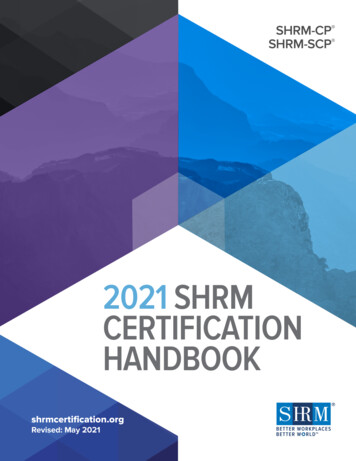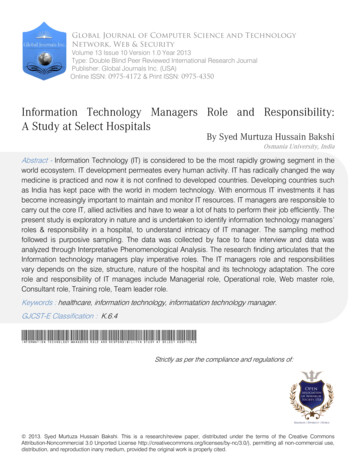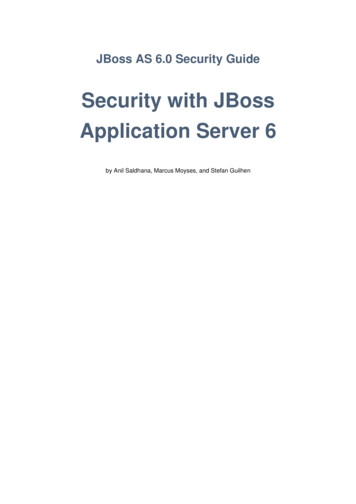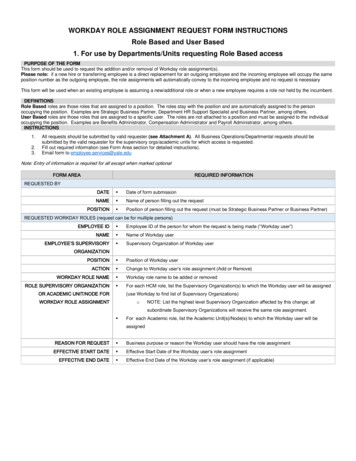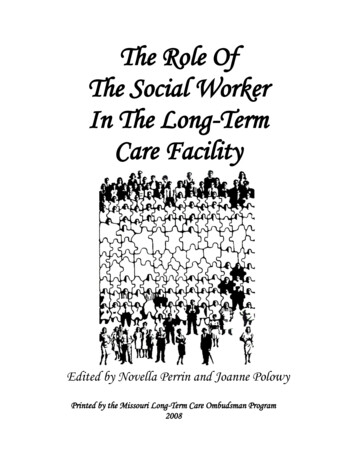
Transcription
The Role OfThe Social WorkerIn The Long-TermCare FacilityEdited by Novella Perrin and Joanne PolowyPrinted by the Missouri Long-Term Care Ombudsman Program2008
Table of ContentsTable of ContentsTable of Contents . 2Acknowledgements . 4Social Worker Ad Hoc Committees . 5Preface to the Revised Edition . 7Chapter1. GENERAL PHILOSOPHY AND GOALS . 8Organization of the Book . 12Terminology . 122. ADMISSIONS . 13Marketing . 13Orientation to the Facility . 14Pre-Admission Coordination . 15Pre-Admission Screening . 16Admission . 17Advance Directives . 18The Social History . 21Resident Rights . 21Discharge Planning . 243. INDIVIDUALIZED SERVICE DELIVERY . 26Resident Contact . 26Recognizing Ethnic and Cultural Diversity . 27Care Planning and the Minimum Data Set (MDS) . 27Identifying Individual Social and Emotional Needs . 28Documentation . 30Social Service Assessment. 30Resident Plan of Care . 31Social Services Progress Notes . 334. PRACTICE AND INTERVENTION SKILLS . 36Traditional Social Work Practice Skills . 36Counseling Skills . 37Crisis Intervention Skills . 39Facilitating Groups . 39Working with Special Need Residents . 40Residents with Cognitive Impairment . 40Younger Residents . 41Low-Need Residents . 42-2-
Chemical and Physical Restraints . 42-3-
5. PROBLEM SOLVING AND COMPLAINT RESOLUTION . 44Problem Identification . 45Problem Resolution . 466. SUPPORT SERVICES . 49Physical and Psychological Abuse/Neglect/Financial Exploitation . 49Financial Assistance . 51Legal Issues. 52Witnessing Forms . 53Interdepartmental Staff Meetings/In-service Training . 547. FINANCIAL RESOURCE MANAGEMENT. 558. VOLUNTEERS . 589. STAFF TRAINING AND DEVELOPMENT . 60Critical Areas of Training Needed by the Social Worker . 61Stress Management for Social Service Workers/Designees . 65GLOSSARY AND WEBSITES. 67BIBLIOGRAPHY. 71COMMUNITY RESOURCES FOR LONG-TERM CARE SOCIAL WORKERS . 73LIST OF MISSOURI COLLEGES AND UNIVERSITIES WITH SOCIALWORK PROGRAMS . 74SAMPLE JOB DESCRIPTION - SOCIAL SERVICE DESIGNEE/WORKER . 75SUGGESTED ADMISSION PACKET CONTENTS . 76ROLE OF THE SOCIAL WORKER IN OLD VS. NEW CULTURE . 80This booklet is dedicated in memory of Garry Thompson, MSW.-4-
AcknowledgementsThe work presented in this booklet is the culmination of a two-year team effort in1985-87. A group of independent practitioners and academicians, working in closecooperation with the staff of the Missouri Division of Aging*, has devoted their time andexpertise in the preparation of this booklet. The efforts of the following people aregreatly appreciated.Luther Gruenbaum, MSWSocial Work ConsultantLutheran AltenheimSt. Louis, MOBarbara PinneyStaff Training CoordinatorDivision of Aging*Jefferson City, MOTheresa Hall, MSWElfindale Land & DevelopmentProject Dir.: Creekside at ElfindaleSpringfield, MOMary SchworerSocial ServicesJohn Knox VillageLee's Summit, MODeloris Johnson, MSWSchool of Social WorkUniversity of MO - St. LouisSt. Louis, MOSharon StoberSocial ServicesJohn Knox VillageLee's Summit, MOJacqueline McCollomAdministratorDexter Convalescent HomeDexter, MOFrancine Thomas, DirectorSocial ServicesTower Village, Inc.St. Louis, MODuane McGuire, MSWLong Term Care OmbudsmanDivision of Aging*Jefferson City, MOSusan VincentAdministratorSt. Joseph's InfirmaryEureka, MOIt is hoped this publication can be used in planning and implementing a socialservice program in a long-term care facility and that it will stimulate and increase anawareness of the need for service integration between components of care in long-termcare facilities. Such heightened awareness should enrich the quality of life for residentsin the long-term care facilities -and it is toward this goal that we are striving.Novella Perrin, PhD.Director, CMSU Gerontology InstituteCentral Missouri State UniversityWarrensburg, MOJoanne Polowy, MSWProgram PlanningDivision of Aging*Jefferson City, MO* Divisionof AgingJoannePolowy,MSWis now the Department of Health and Senior Services.-5-
Social Worker Ad Hoc Committee1992-1993The revision of this book is the result of a team effort of practitioners,academicians, and Division of Aging* staff. Almost all of the original material has beenincorporated but as there have been a number of changes in laws, regulations, andpublic policy, particularly on the federal level, the booklet needed to be updated. Theinput, cooperation, and dedication of the following people are greatly appreciated.Pam Clark, ACSWProgram Manager IIDivision of Aging* - Region 7111 North 7th, Room 500St. Louis, MO 63101Janet R. Walker, BSDirector of Social ServicesLoch Haven Nursing HomeP.O. Box 187Macon, MO 63552Roxana CrawleyBent Wood Nursing Center1501 Charbonier RoadFlorissant, MO 63031Jan Pearson, CSW 11Division of Aging* - Region 3615 East 13th, 4th FloorKansas City, MO 64106Stephanie Friedman, ACSW#11 Dogwood LaneSt. Louis, MO 63124Geneen Morgan, MSW2610 Whitegate DriveColumbia, MO 65202Dennis Longwell, CSW IDivision of Aging* - Region 1149 Park Central SquareSpringfield, MO 65806Mary Schworer, MSWFoxwood Springs Living Center1500 W. Foxwood Dr., Box 1400Raymore, MO 64083Jeanne CampbellJohnson County Care Center122 East MarketWarrensburg, MO 64093Deloris Johnson, MSW103 5 Lewellyn Lane, Apt. 2Olivette, MO 63132Gary Thompson, MSWFacility Surveyor IIIDivision of Aging*Jefferson City, MO 65102CoordinatorsNovella Perrin, PhD.Director, Gerontology InstituteCentral Missouri State UniversityWood 136 NWarrensburg, MO 64093Joanne Polowy, MSWManager, Central OperationsMissouri Division of Aging*Jefferson City, MO 65102* Division of Aging is now the Department of Health and Senior Services.-6-
Social Worker Ad Hoc Committee2003-2004The revision of this book is the result of a team effort of practitioners,academicians, and Department of Health and Senior Services staff. Almost all of theoriginal material has been incorporated but as there have been a number of changes inlaws, regulations, and public policy, particularly on the federal level, the booklet neededto be updated. The input, cooperation, and dedication of the following people are greatlyappreciated.Danette Beeson,Program ManagerDepartment of Health and Senior ServicesJefferson City, MO 65102Margaret Stone, Ph.D.Central Missouri State UniversityWarrensburg, MO 64093Theresa Hall, MSWElfindale Land & DevelopmentProject Dir.: Creekside at ElfindaleSpringfield, MO 65807Garry Thompson, MSWFacility Surveyor IIIDepartment of Health and Senior ServicesJefferson City, MO 65102Kim Ireland, Director of OperationsTiffany Care Centers, Inc.Mound City, MO 64470Mary Toliver, Director of Social ServicesLutheran Good Shepherd Home/Lutheran Nursing home202 South West StreetConcordia, MO 64020Sandy Sanders, Admissions Coordinator/Social Services DirectorHeritage Hall Nursing Center750 E. Highway 22Centralia, MO 65240Ranae Walrath, Alzheimer’s Care DirectorWestwood Nursing Center1801 Gaines DriveClinton, MO 64735Melissa Steck, Social ServicesBishop Spencer PlaceKansas City, MORose WheelerKingswood Health Center10000 Wornall RoadKansas City, MO 64114CoordinatorsNovella Perrin, Ph.D.Central Missouri State UniversityWarrensburg, MO 64093Julie Ballard , RNAssistant State LTC OmbudsmanDepartment of Health and Senior ServicesJefferson City, MO 65102Garry Thompson, MSWFacility Surveyor IIIDepartment of Health and Senior ServicesJefferson City, MO 65102Carrie Eckles, MSWAssistant State LTC OmbudsmanDepartment of Health and Senior ServicesJefferson City, MO 6510-7-
Social Worker Updates2005-2006The revision of this book is the result of a team effort of practitioners,academicians, and Department of Health and Senior Services staff. Almost all of theoriginal material has been incorporated but as there have been a number of changes inlaws, regulations, and public policy, particularly on the federal level, the booklet neededto be updated. The input, cooperation, and dedication of the following people are greatlyappreciated.CoordinatorsMary Wehrle, B.S.Manager, Bureau of Program IntegrityDivision of Senior and Disability ServicesDepartment of Health and Senior ServicesJefferson City, MO 65102Carrie Eckles, MSWAssistant State LTC OmbudsmanLTC Ombudsman ProgramDepartment of Health and Senior ServicesJefferson City, MO 65102Garry Thompson, MSWFacility Surveyor IIISection for Long Term CareDepartment of Health and Senior ServicesJefferson City, MO 65102Preface to the Revised EditionThe information in this booklet is intended to serve as a guide for the delivery ofsocial services in long-term care facilities. The booklet was purposefully written in abroad manner to allow applicability to the wide range of long-term care and assistedliving facilities that exist in the state. It is left to the reader to implement the informationin the manner most appropriate to the individual facility.This information should be viewed as a yardstick against which one can measurethe quality and effectiveness of social service delivery. Although there are no penaltiesassociated with noncompliance to this booklet's recommendations*, it is hoped thereader will be challenged to strive for the attainment of the highest standards. It istoward this goal of high quality social service delivery that this book has been directed.*Many of the guidelines suggested in this booklet are based on state and federalregulations which do carry such penalties for noncompliance.-8-
The Role of the Social Workerin the Long-Term Care FacilityChapter 1General Philosophy"Are the old really human beings? Judging by the way our societytreats them, the question is open to doubt. Since it refuses them what theyconsider the necessary minimum, and since it deliberately condemnsthem to the extreme poverty, to slums, to ill health, loneliness and despair,it asserts that they have neither the same needs nor the same rights asother members of the community. In order to soothe its conscience, oursociety's ideologists have invented a certain number of myths - myths thatcontradict one another, by the way - which induce those in the prime of lifeto see the aged not as fellow beings but as another kind of beingaltogether."Simone de BeauvoirThe Coming of AgeThe writings of de Beauvoir reflect the prevailing societal view of the nineteenthcentury toward older persons and indeed may still represent the attitude of certainelements of today's population. However, the general philosophy upon which thisbooklet is based takes a more optimistic view of older adults. It is the basic premise ofthe authors that each person, whether living independently or living in a long-term carefacility, is unique; has the same basic needs as all others; and is entitled to the samerights.The role of the socialworker in a long-termcare facility is to enableeach individual tofunction at the highestpossible level of socialand emotional wellness.A social worker in a long-term care facility helpsthe person who is entering a facility make the transitionfrom a previous living environment to life in aninstitutional setting while meeting the social/emotionalcomfort needs of that resident. Once the resident isestablished, the social worker assures the resident'scontinuing needs are met and that the person is given the opportunity to participate inplanning for continued care in the facility, transfer, or discharge back into the-9-
community. Although the resident is the main focus, it should be noted that much of thesocial worker’s time may be spent working with the family.To assure positive well-being for the resident, social workers should adopt aholistic perspective by recognizing the dynamic interplay of social, psychological,physical, and spiritual well-being. The social worker must constantly be aware of factorswhich may have a negative impact upon a resident's well-being and, if possible, preventthis from occurring. Further, the social worker must interact with all levels of staff withinthe facility as well as the residents and their families and friends; this is essential toenhancing the opportunity for the resident's positive life experience while in a long-termcare facility.The social worker's role should be guided by the following philosophy. Thesocial worker:1. Is aware of the worth and uniqueness of each individual2. Treats each individual with respect3. Creates an atmosphere of growth for the individual4. Adopts a holistic perspective by recognizing the dynamic interplay of social,psychological, physical, and spiritual well-being5. Provides a physical environment that is supportive rather than challengingor crippling to the individual6. Fosters a positive self-image for the residents through continued socialcontact, decision-making opportunities, and independenceSpecific tasks which may be a part of the social worker's duties generallyinclude but are not limited to:Marketing and providing tours for potential residents and familiesPlanning for pre-admission and dischargeProviding psycho-social assessment and completion of relevant parts of theminimum data set (particularly face sheets, sections A, AA, AB, AC, E, F, Q andsometimes B)Utilizing the minimum data set to guide the care plan- 10 -
Participating (as a member of an interdisciplinary team) in resident care planningCounseling residents and their familiesContacting and utilizing community resources on the resident's behalf andserving as a link between the resident and these resource systems whennecessaryAdvocating for and protecting resident's rightsEnsuring the social and emotional needs of each resident are metStimulating social contact and interactionPromoting the maximum level of independence of each residentPromoting volunteerism for the facilitySurvey research has indicated there is a limited understanding of whatconstitutes a comprehensive social service program in long-term care facilities. Thus,the information in this booklet is intended to serve as a guide for the delivery of socialservices in a long-term care facility. It has been developed to be used not only by asocial worker/social service designee, but also by an administrator and others on thestaff of a facility.All long-term care staff must understand and be aware of thenecessary components of social work in a long-term care facility, the range of servicesassociated with each component, and the various duties a person designated asresponsible for social services may be called upon to perform. The administrator, inparticular, needs to understand the complexity of what is involved in meeting aresident's social and emotional needs and should provide as much support to the socialservice staff as possible to assure that those needs can be met.- 11 -
The components included in this booklet should be considered as basic. Theyinclude: admission, information and referral, counseling, problem-solving and complaintresolution, support services, financial resource management, and individual servicedelivery. For each of these basic components there is a brief explanation, a descriptionof the range of services which may be available, and the possible associated duties.The facility social worker may be called upon to do any or all of these components.The goals of this booklet are: To provide a general philosophy regarding social service delivery inlong-term care facilities; To set forth the basic components of a social service program in a longterm care facility; To clarify the role of the social worker/social service designee in a longterm care facility; To increase awareness of the multiple duties of a long-term care socialservice worker/social service designee; To improve the quality of social services in long-term care facilities; To provide resources for further information on social work in long-termcare settings; To provide a sample job description for a social worker/social servicedesignee.When utilizing the information presented herein, it is necessary to remember thatall long-term care facilities are not alike. Long-term care facilities differ according tosize, location, organizational structure, proprietorship, level of care, staff, staffbackground and experience, resident population and cost. Although some of thesecharacteristics may seem unrelated to social service delivery, they all impact aresident's life and care. It is necessary for the reader to understand the informationprovided in this booklet must be individualized and adapted for each facility to bestserve the needs of the residents in that facility. It is for this reason that a range ofservices or duties is presented for each of the basic components. Each of these areas- 12 -
must be addressed in some way if the social and emotional needs of residents are to bemet.Organization of the BookThis book is organized in a logical progression of tasks that may be required of asocial worker in providing services to residents. Following the first introductory chapter,chapter two discusses admission of the resident to the long-term care facility, the thirdchapter presents components of individualized service delivery to the resident afteradmission; and the fourth through eighth chapters detail additional services a socialworker may be asked to provide or assist in obtaining. The final chapter describes thetypes of on-going training needed by the social worker to enhance service delivery andprofessional development. The concluding sections list accredited social work programsin Missouri, sample job descriptions for social workers, common abbreviations used inthe service delivery system, and possible contents for an admission packet. A glossaryof terms and related websites also are included.TerminologyThe terms "social worker" and "social service designee" are terms that aredefined in federal and state regulations. (See section on Sample Job Descriptions).However, the terms "social service worker,‖ "social worker,‖ "worker,‖ or ―designee‖ areused interchangeably in this book.According to RSMo 337.604, no person shall hold himself or herself out to be a"social worker" unless such person has: (1) Received a baccalaureate or master'sdegree in social work from an accredited social work program approved by the councilon social work education; (2) Received a doctorate or Ph.D. in social work; or (3) Acurrent baccalaureate or clinical social worker license as set forth in sections 337.600 to337.689. No government entities, public or private agencies or organizations in thestate shall use the title "social worker" or any form of the title for volunteer oremployment positions, etc., unless the volunteers or employees in those positions meetthe criteria set forth in subdivision (8) of section 337.600 or subsection 1 of this section.- 13 -
Chapter 2AdmissionsAdmission of a resident to a long-term care facility is a significant event for thenew resident, his/her family, friends and facility staff. It is not an event that simplyhappens; it requires thorough yet individualized pre-admission planning andcoordination. Ideally, each admission has pre-admission coordination that includes atour of the facility, interaction with staff, proper screening, and explanation of services,policies and procedures. Unfortunately, in many cases the facility has only a few hoursto prepare.Even with short notification, the new resident and familyshould beprovided with as much information as possible to assist in the transition.MarketingThe pre-admission process may begin months or years prior to the actualadmission. The pre-admission process begins with marketing. Every staff member hasthe responsibility to market the facility. Every contact made with a person outside thefacility has some impact. One never knows when a family member is looking for afacility or will recall a positive or negative interaction when seeking placement for aloved one. Although each employee is a representative of the facility, actual marketingtasks are frequently listed as a part of the social worker’s job description. If marketingis a part of the performance expectation, the following list provides key marketingconcepts:Know the facilities in the area and what level of care is offered in each. Otherfacilities may serve as ―feeders‖ to the facility or may be a more appropriateplacement for the resident.Stay in contact with all referral sources so that referrals will continue. Keepthe referral sources informed about current vacancies and services the facilitycan provide.Network with other social workers in other facilities andhospitals.Utilize a variety of methods such as positive news releases, open houses, andeducational programs, to keep the facility name constantly in the public eye.- 14 -
Help keep the facility looking attractive.Although many could argue thatquality of care is the most important aspect of any facility, if the facility doesnot look inviting, there may be no residents to whom to provide services.Orientation to the FacilityIn some facilities, ―marketing‖ simply refers to tours of the facility. Such tours areusually hosted by the social worker. This sets the stage for an ongoing relationshipbetween the social worker, the resident, and the resident's family (if any) as the socialservice worker may be the person to whom a family and the resident (if admitted) willturn for later assistance.Literature (brochures or pamphlets) with photographs of the facility should bedeveloped to distribute during tours or pre-admission inquiries. At a minimum thefollowing information should be presented during a tour or in the "marketing" process: Facility rates - including information on services included and not included in therate Description of rooms available Visiting hours Activity programs In-room services (i.e. television, telephone) Ancillary services (physical, occupational and speech therapies, dentalservices, beauty shop, laundry) Physician services Facility policies regarding personal property, admission, discharge, bedholding and outings into the communityAlso, it is helpful to have other flyers and pamphlets available regardingMedicare, Medicaid, Social Security, and other programs which affect and assist olderpersons and their families. The Department of Health and Senior Services has some- 15 -
excellent material available on these issues which can be obtained free of charge. Thismaterial and the facility flyer should be given to prospective residents and their familiesfor them to take home and study.Pre-Admission CoordinationA potential resident should always be encouraged to visit the facility beforeadmission and should be encouraged to actively participate in the selection andadmission process. If the person cannot visit the home, ideally, the social serviceworker should go to the person's home (or the hospital) to describe thefacility, services and answer questions. If this is not possible and theperson is coming to the facility directly from a hospital, communicatingwith the hospital social worker is essential. Also, meeting with familymembers or significant others before admission is a key factor in facilitating adjustmentfor the potential resident. If the resident has not already seen a brochure or videotapeabout the nursing home which includes pictures of rooms, floor plans of the facility andgrounds, and special features of the facility, it should be given to the resident to assist infamiliarization with the facility. In some cases, it may be appropriate to give the brochureor brochure to the resident's family so they may assist in the orientation process.Many residents may be cognitively impaired and unable to participate in the decisionmaking process. Even so, the resident should be included in as much of the processas he/she is able to understand.In order to facilitate a resident's transition from independent living to that of livingin a new environment, it is essential to gather as much detailed information as possibleabout the resident, background, and family. This should be completed before admissionto ensure proper placement and to enable staff to provide needed services. Informationthat is needed before admission includes: financial data, insurance coverage, burialarrangements, responsible parties/families, religious preferences, and physicianpreference. It may be helpful to supply local hospital social workers with a checklist orcopy of the facility pre-admission form so they know what type of information is needed.The information should not be used for any purposes other than those designated by- 16 -
the policies of the nursing home or state and federal regulations. Remember that allinformation regarding the resident is confidential.Prior to admission, it also may be the social service worker's responsibility toobtain any ancillary equipment or services needed by a potential resident. These mayinclude specialized medical. equipment, (i.e. special bed, wheelchair, oxygen,respirator) or external services (i.e. transportation, ambulance services).The social service worker’s involvement in this process will varydepending on the policies of the particular facility and the particularneeds/requests of the resident. Some facilities, for instance, have thesocial service worker assign the room based on both medical andsocial aspects involved.In some facilities, the administrator or director of nursing may take the lead rolein the admission process. Even if this is the case, the social worker should have anopportunity to meet with both the resident and the family to let them know of ways theworker can be helpful to them after admission.Pre-Admission ScreeningFederal regulations require that all prospective residents be screened for theProspectiveresidents who arepotentially Medicaideligible must bescreened by MissouriDepartment of Healthand Senior Servicesstaff members asmandated by theMissouri CareOptions Program:Level 2, according tothe DA124C form.possibility of a mental illness or developmentallydisabled diagnosis. The pre-admission screen is knownas PASARR which stands for Pre-Admission Screenand Resident Review.Compliance with PASARR isensured by completion of the DA124 form. The DA124form is divided into three parts, A, B, and C. DA124Aand DA124B screen for the possibility of a mentally ill ng the
the authors that each person, whether living independently or living in a long-term care facility, is unique; has the same basic needs as all others; and is entitled to the same rights. A social worker in a long-term care facility helps the person who is entering a facility make the transition





